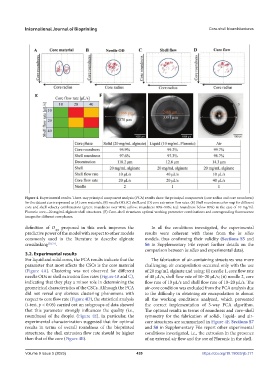Page 447 - IJB-9-5
P. 447
International Journal of Bioprinting Core-shell bioarchitectures
Figure 4. Experimental results. Three-way principal component analysis (PCA) results show the principal components (core radius and core roundness)
for the dataset z axis expressed as (A) core materials, (B) needle OD, (C) shell, and (D) core extrusion flow rates. (E) Shell roundness color map for different
core and shell velocity combinations (green: roundness over 90%; yellow: roundness 80%–90%; red: roundness below 80%) in the case of 10 mg/mL
Pluronic core—20 mg/mL alginate shell structures. (F) Core–shell structures optimal working parameter combinations and corresponding fluorescence
images for different core phases.
definition of D proposed in this work improves the In all the conditions investigated, the experimental
app
predictive power of the model with respect to other models results were coherent with those from the in silico
commonly used in the literature to describe alginate models, thus confirming their validity (Sections S5 and
crosslinking [30,31] . S6 in Supplementary File report further details on the
comparison between in silico and experimental data).
3.2. Experimental results
For liquid and solid cores, the PCA results indicate that the The fabrication of air-containing structures was more
parameter that most affects the CSCs is the core material challenging: air encapsulation occurred only with the use
(Figure 4A). Clustering was not observed for different of 20 mg/mL alginate and using: (i) needle 1, core flow rate
needle ODs or shell extrusion flow rates (Figure 4B and C), of 40 µL/s, shell flow rate of 10–20 µL/s; (ii) needle 2, core
indicating that they play a minor role in determining the flow rate of 10 µL/s and shell flow rate of 10–20 µL/s. The
geometrical characteristics of the CSCs. Although the PCA air-core condition was excluded from the PCA analysis due
did not reveal any obvious clustering phenomena with to the difficulty in obtaining air encapsulation in almost
respect to core flow rate (Figure 4D), the statistical analysis all the working conditions analyzed, which prevented
(t-test, p < 0.05) carried out on subgroups of data showed the correct implementation of 3-way PCA algorithm.
that this parameter strongly influences the quality (i.e., The optimal results in terms of roundness and core–shell
roundness) of the droplet (Figure 4E). In particular, the symmetry for the fabrication of solid-, liquid- and air-
experimental characterization suggested that for optimal core structures are summarized in Figure 4F. Sections S7
results in terms of overall roundness of the bioprinted and S8 in Supplementary File report other experimental
structures, the shell extrusion flow rate should be higher conditions investigated, i.e., the extrusion in the presence
than that of the core (Figure 4E). of an external air flow and the use of Pluronic in the shell.
Volume 9 Issue 5 (2023) 439 https://doi.org/10.18063/ijb.771

